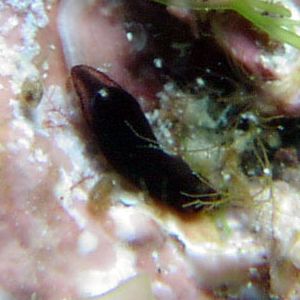
Metaruncina setoensis
(Baba, 1954)
Order: CEPHALASPIDEA
Superfamily: RUNCINOIDEA
Family: Runcinidae
DISTRIBUTION
Known only from central Japan.
PHOTO
Hachijo Island, Japan. July 2001. Photo: Jun Imamoto.
Small black runcinid with a submarginal translucent yellowish band down each side of the mantle to join posteriorly. A similar submarginal band occurs on the foot. In some specimens, the submarginal band appears reddish. The small reduced shell is totally enclosed in the posterior part of the mantle. Particularly common in Autumn (September - November) in shallow upper tidal pools, crawling on rocky bottom or on juvenile plants of the filamentous green alga Enteromorpha. Grows to approximately 7mm in length. It has direct developing larvae which hatch from the egg as crawling young about 40 days after laying. During development in the egg, the embryo passes through a recognisable, but modified, veliger stage.
References:
• Baba, K. (1954) Runcina setoensis, a new and rare species from the coast of Kii, Middle Japan (Opisthobranchia). Publications of the Seto Marine Biological Laboratory, 3: 373-374.
• Baba, K. (1967) Supplementary notes on the anatomy of Metaruncina setoensis (Baba, 1954), (N.G.) (Opisthobranchia - Cephalaspidea). Publications of the Seto Marine Biological Laboratory, 15: 185-197, Pls 2-5.
• Baba, K. & Hamatani, I. (1959) The direct development in Runcina setoensis Baba (Opisthobranchia- Cephalaspidea). Publications of the Seto Marine Biological Laboratory, 7: 281-290.
Rudman, W.B., 2001 (July 9) Metaruncina setoensis (Baba, 1954). [In] Sea Slug Forum. Australian Museum, Sydney. Available from http://www.seaslugforum.net/find/metaseto
Related messages
Re: Metaruncina setoensis - external shell?
July 30, 2003
From: Jun Imamoto

Dear Bill.
Thank you for your comment. I attach an additional image. The white thing may be a shell.
26 Jul 2003
Manazuru-coast Sagami Bay, Japan
size about: 4mm
depth: 0.3m (Intertidal)
temperature:24 C
Best Regards,
Jun Imamoto
imamoto@umiushi.info
Imamoto. J., 2003 (Jul 30) Re: Metaruncina setoensis - external shell?. [Message in] Sea Slug Forum. Australian Museum, Sydney. Available from http://www.seaslugforum.net/find/10594Dear Jun,
Thanks for the photo. It certainly looks like a shell. We really need to know whether the 'shell' is covered by the skin or exposed. If it is exposed then either the shell of Metaruncina setoensis is sometimes internal and sometimes external, or else this animal is not Metaruncina setoensis but perhaps a species of Ildica, the genus Bergh described for Ildica nana, an animal with an external shell. The shape of the radular teeth should certainly be one way of determining whether it is M. setoensis.
Best wishes,
Bill Rudman
Metaruncina setoensis - external shell?
July 28, 2003
From: Jun Imamoto

Dear Bill.
Here are some more detailed pictures I have taken of Metaruncina setoensis than the ones I sent before. I am happy if these reports are useful for your research.
date: 26 Jul 2003
place: Manazuru-coast Sagami Bay, Japan
size about: 4mm
depth: 0.3m (Intertidal)
temperature: 24 C
Best Regards,
Jun Imamoto
www.umiushi.info
imamoto@umiushi.info


Dear Jun,
Thanks for these useful photos. I am particularly interested in the white patch at the back of the body. This is where the internal shell of Metaruncina setoensis is situated, but since it is described as 'internal' it should not be visible. Looking at your earlier photos I can see the same white spot. I missed it earlier because I thought it was another white particle in the water floating over the animal when the photo was taken. In most published illustrations I have seen of this species there has not been a white patch like this. However I have just checked the photo in Marine Mollusks in Japan [Pl. 378, f. 2] and can see a white spot in the same position as in your photo. Hamatani, who wrote this section of the book, places Metaruncina setoensis in the Family Ildicidae which he defines as "Body with external shell..". This is quite contradictory to earlier descriptions of Metaruncina setoensis in which the shell is described as internal.
I am not sure from your photos whether the shell in your animal is external or whether it is internal but so close to the surface that it is easily seen. If it is external then either the position of the shell in Metaruncina setoensis is variable or there are two very similar species, one with an external shell and one with an internal shell. In the lower left close-up, the external gill can be seen to the right of the 'shell'. If you can help us with any more details on this puzzling white patch, I would be very interested.
• Hamatani, I. (2000) Runcinacea: 759, Pl. 378 figs 1,2. [In} Okutani, T. Marine Mollusks in Japan. Tokai University Press: Tokyo.
Best wishes,
Bill Rudman
Metaruncina setoensis f rom Japan
July 11, 2001
From: Jun Imamoto

Dear Dr.Rudman,
I found a interesting animal at Hachijo Island, Japan last week [July 2001}. I thought that it's a kind of Chelidonura but soon I noticed it's
tail. I believe that this is a Metaruncina setoensis. I attached 3 images that
I took. I would be very happy if I could hear your comment.
Best Regards,
Jun Imamoto
Imamoto@hpe15.wips.co.jp


Dear Jun Imamoto,
Your animal is Metaruncina setoensis, as you thought. Apart from their very small size, one way they differ from Chelidonura and other aglajids is they do do have a separate head shield, so there is no backward directed flap about halfway down the back on a runcinid.
best wishes,
Bill Rudman
